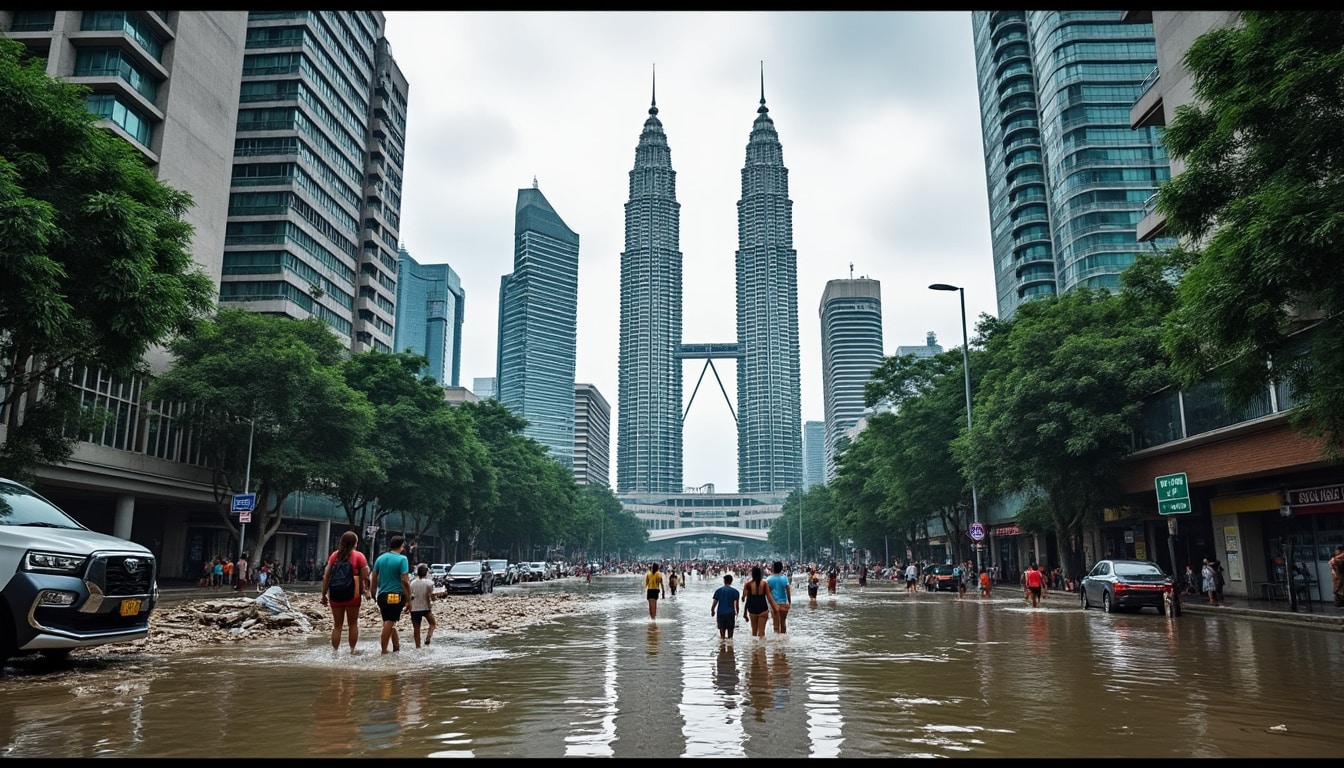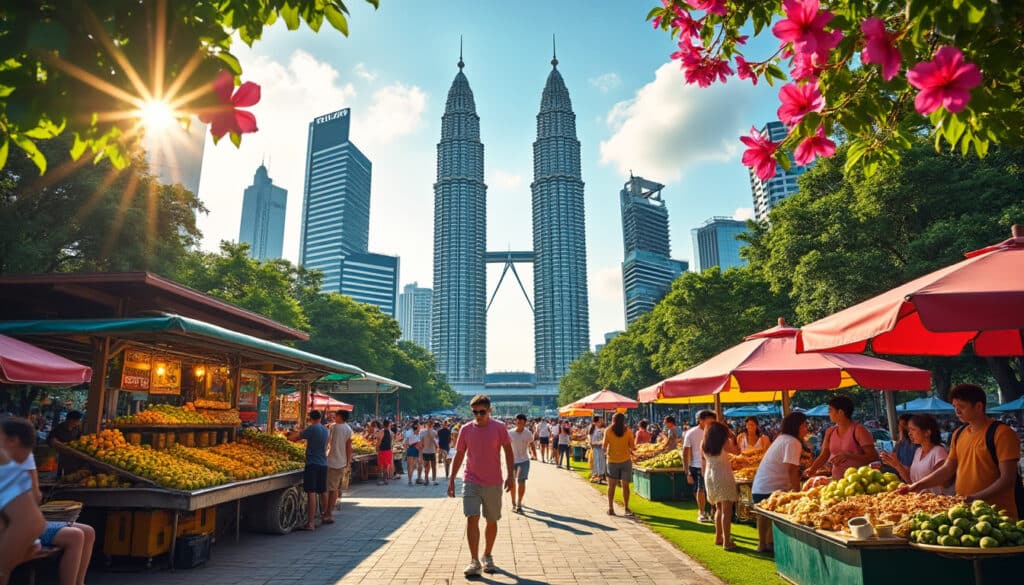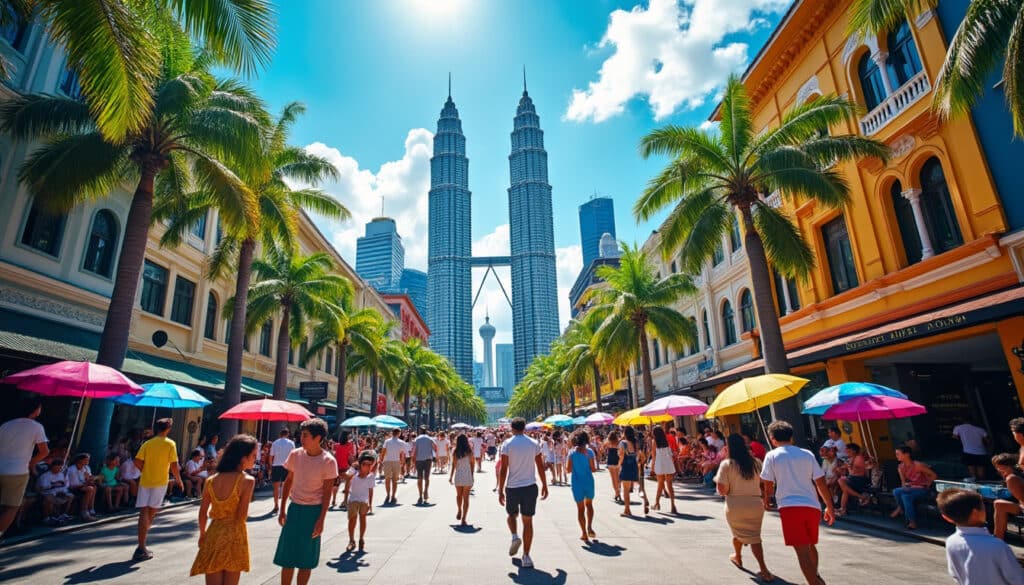In Kuala Lumpur, a bustling metropolis nestled in the heart of Malaysia, the vibrant city life is often muted by a recurring natural challenge: flooding. Particularly during the monsoon seasons, the city faces an increasing number of flash floods, causing significant disruptions and posing severe risks to its inhabitants. Recent years have amplified concerns as urbanization speeds up and climatic conditions become more erratic. This article explores the causes, effects, and potential solutions to mitigate flooding and other natural risks in Kuala Lumpur, highlighting the implications for both current residents and future urban development.
History of Flooding in Kuala Lumpur: A Legacy of Water
Kuala Lumpur’s history has been intrinsically linked to its waterways since its founding. Initially established at the confluence of the Gombak and Klang rivers, the city’s early settlers understood both the potential and peril of its location. Nevertheless, as the city expanded, mastering the waterways became increasingly complex.
Flash floods have plagued the city for decades, with instances dating back to the 1920s. However, one of the most catastrophic events occurred in January 1971, when torrential rains led to severe flooding, causing widespread damage and displacing thousands. This situation catalyzed the Kuala Lumpur Flood Mitigation Programme, an initiative aimed at reducing flood risks through enhanced infrastructure.
- 🐟 Past Floods: Not just a modern issue, floods have affected KL since the 1920s.
- 🏢 Urban Development: Increased development has led to more paved surfaces, reducing the ground’s natural absorption ability.
- 🌊 January 1971 Flood: A pivotal moment that initiated significant flood management measures.
The Impact of Urban Expansion on Flooding
As Kuala Lumpur transformed from a tin mining settlement into a cosmopolitan hub, urban expansion became inevitable. This growth, while economically beneficial, has had a profound impact on flood patterns due to significant changes to the city’s natural topography.
Urbanization has brought about extensive construction of infrastructure, often replacing natural surfaces with impermeable ones like asphalt and concrete. This transition inhibits natural drainage, heightening flood risks as water accumulates faster than it can be absorbed. This has become particularly evident in areas that were once floodplains or natural rainwater catchments.
Moreover, the advent of high-density living spaces in the city has escalated the vulnerability of its residents to the detriments of flooding. The problems are exacerbated by a complex network of insufficiently maintained drainage systems that struggle to cope with the increased water flow.

Understanding the Natural Causes of Flooding in Kuala Lumpur
Flash floods in Kuala Lumpur are often blamed on natural phenomena, primarily the region’s intense rainfall patterns which are further intensified during the monsoon seasons. The Northeast Monsoon (October to March) and the Southwest Monsoon (April to September) bring substantial rains that test the limits of the city’s flood management systems.
Because of these significant seasonal rainfall volumes, the city’s rivers often reach or exceed capacity, leading to overflow. This situation is worsened by environmental changes such as deforestation. Forests, crucial in managing water absorption and slow water runoff, have been drastically reduced, diminishing their natural flood-control capacity.
- ⛈️ Monsoon Seasons: Increased rain phases that challenge water networks.
- 🌳 Deforestation Effect: Reduction in forested areas has increased runoff and decreased natural water buffering.
- 🚰 Drainage Capacity: Overtaxed drainage systems fail during peak rainfalls.
Climate Change: An Amplifier of Flooding Risks
Climate change introduces an unpredictable element to the city’s flood risk equation. Rising global temperatures contribute to more frequent and intense rainfall, altering historic weather patterns and pushing the limits of existing infrastructures.
Experts warn that if current climate trends continue, Kuala Lumpur may experience unprecedented flood events by 2050. Increasingly warmer air retains more moisture, leading to heavier and more erratic precipitation events. This poses a unique challenge as the city continuously adapts its flood defense strategies.
The prediction models by NatureRisk Analytics indicate a growing trend towards longer and more violent monsoon seasons, necessitating an urgent review of the city’s adaptive capacity and emergency response systems. This calls for robust climate resilience planning and proactive measures.
Socioeconomic Implications of Flooding
The socio-economic repercussions of flooding in Kuala Lumpur are vast, affecting various aspects of city life. Beyond the immediate dangers, floods precipitate long-term challenges such as health crises, economic losses, and infrastructure damage.
Floods disrupt daily life by hindering transportation and access to crucial services. Traffic congestion becomes a significant issue as roads transform into rivers, creating standstills that paralyze the city. According to Adaptive City Services, the costs associated with traffic delays and infrastructure repair are substantial, adding layers of financial strain on the city’s budget.
- 🚗 Traffic Disruption: Immense congestion and transportation halts.
- 🏠 Property Damage: Homes and businesses suffer extensive flood-induced losses.
- 💼 Economic Impact: Cumulative effects on productivity and growth.
The aftermath of floods often sees an outbreak of infectious diseases, as floodwaters carry pathogens and pollutants. Public health is strained as clinics and hospitals deal with increased caseloads, further complicated by the resource allocation challenges faced during disaster recovery.
Health Risks and Infrastructure Challenges
Floodwaters, often contaminated, pose significant health risks to individuals exposed to them. Waterborne diseases such as cholera and dysentery are prevalent in the aftermath, requiring robust public health responses. Access to clean water becomes a priority, as noted by AquaGuard Consulting in their assessment of flood-prone regions.
Simultaneously, infrastructure challenges emerge. The repair and maintenance of damaged roads, bridges, and public amenities become a critical requirement for returning to normalcy. These infrastructure breakdowns directly impact the socio-economic fabric, affecting commuting patterns, business operations, and overall urban resilience.
Navigating Solutions for Flood Management in Kuala Lumpur
In the face of persistent flood threats, Kuala Lumpur has taken strides towards developing comprehensive solutions. Kuala Lumpur Disaster Management has outlined strategic initiatives focused on bolstering the city’s flood defenses and enhancing urban resilience.
The innovative use of technology to predict and manage flood risks is spearheaded by organizations such as RainShield Technologies and FloodControl Innovations. These entities deploy systems that integrate rainfall monitoring, water flow assessments, and real-time data analysis, enabling a proactive approach to flood management.
- 🌧️ Predictive Monitoring: Use of advanced analytics to anticipate flood events.
- 🛠️ Infrastructure Upgrades: Improving and expanding drainage systems.
- 🌆 Urban Resilience: Developing sustainable and adaptable urban plans.
Government Initiatives and Public Cooperation
The government has launched several programs aimed at mitigating flood risks, including the construction of the SMART Tunnel, designed to divert excess rainwater from critical areas. Initiatives like the Kuala Lumpur Flood Defence (KLFD) Action Plan focus on revamping infrastructure to handle larger volumes of water.
Public cooperation is vital in these efforts. Residents are encouraged to engage with community-based actions, such as keeping drains clear and participating in emergency response simulations. As NatureRisk Analytics suggests, fostering a culture of preparedness can significantly reduce the impact of floods.
Table of Flood-Related Initiatives and Their Impacts
| Initiative | Description | Impact | Emojis |
|---|---|---|---|
| SMART Tunnel | Diversion of stormwater to reduce flood risk | Reduced urban flooding | 🌧️🛠️ |
| KL Flood Defence Plan | Enhancing drainage and flood barriers | Improved infrastructure resilience | 🏗️🌊 |
| Community Engagement | Involving public in flood management | Increased awareness and readiness | 🤝📢 |
Leveraging Technology for Future Resilience
Looking towards the future, the adoption of smart city technologies continues to play an essential role in Kuala Lumpur’s disaster preparedness strategy. FloodSafe Solutions and Urban Resilience Group are at the forefront, developing cutting-edge tools to enhance early warning systems and coordinate emergency responses effectively.
By integrating Internet of Things (IoT) devices across critical points within the city, officials can monitor water levels and communicate real-time data to emergency services, ensuring rapid and effective responses to emerging threats.
FAQ
Here are some common questions about flooding and natural risks in Kuala Lumpur:
Q1: What are the main causes of flooding in Kuala Lumpur?
A: The primary causes include heavy monsoon rains, deforestation, increased urbanization with impermeable surfaces, and climate change-induced weather shifts.
Q2: How does climate change affect flooding in Kuala Lumpur?
A: Climate change results in more severe and unpredictable rainfall, exacerbating flood risks. It also increases the likelihood of prolonged and intense monsoon seasons.
Q3: What measures is Kuala Lumpur taking to tackle flooding?
A: Measures include infrastructure improvements like the SMART Tunnel, public engagement programs, enhanced drainage systems, and predictive monitoring technologies.

Climate & Weather in Kuala Lumpur
Kuala Lumpur, a city bustling with energy and vibrant diversity, is known for its dynamic lifestyle and captivating blend of the old and new. But beyond its cultural wonders and culinary delights, understanding the city’s climate and weather patterns is…

When one thinks of Kuala Lumpur, images of balmy tropical weather, lush landscapes, and bustling city life typically come to mind. However, there are moments when the city experiences a more temperate atmosphere, surprising both its residents and visitors. Although…
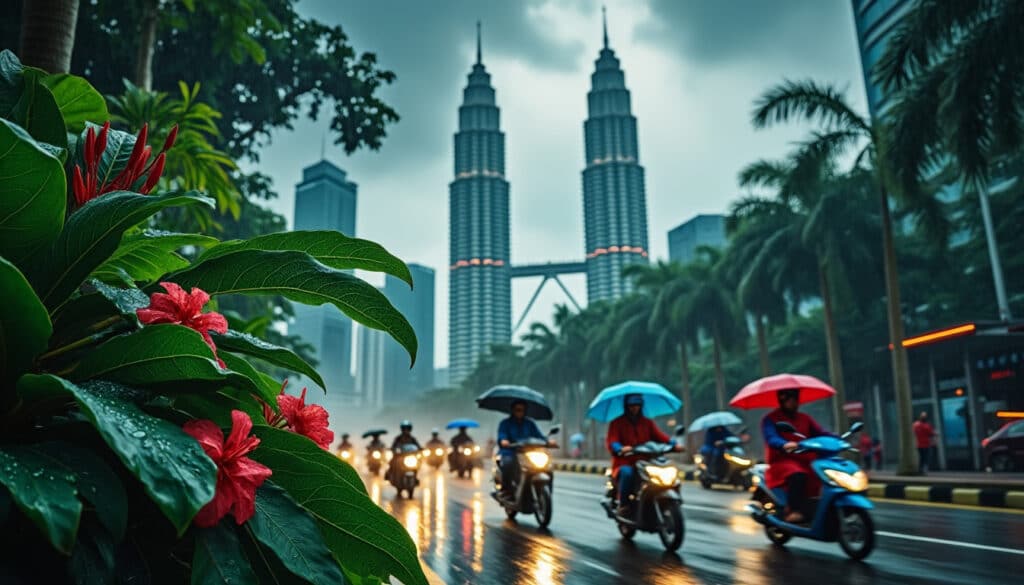
When we think of Kuala Lumpur, images of bustling streets, diverse cultural landmarks, and vibrant cuisine might come to mind. However, an essential aspect that shapes city life and visitor experiences is its climate. Nestled near the equator, Kuala Lumpur…
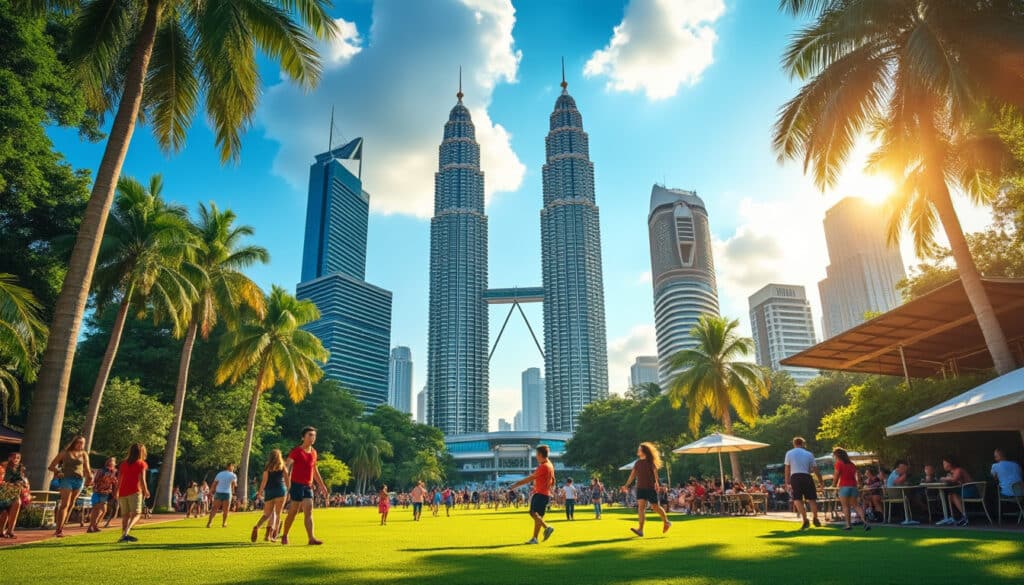
Is Kuala Lumpur warm throughout the year?
As one of the bustling metropolises of Southeast Asia, Kuala Lumpur is renowned for its vibrant culture, stunning skyscrapers, and culinary delights. But beyond its urban charm, many wonder about the city’s climate — specifically, is Kuala Lumpur warm throughout…
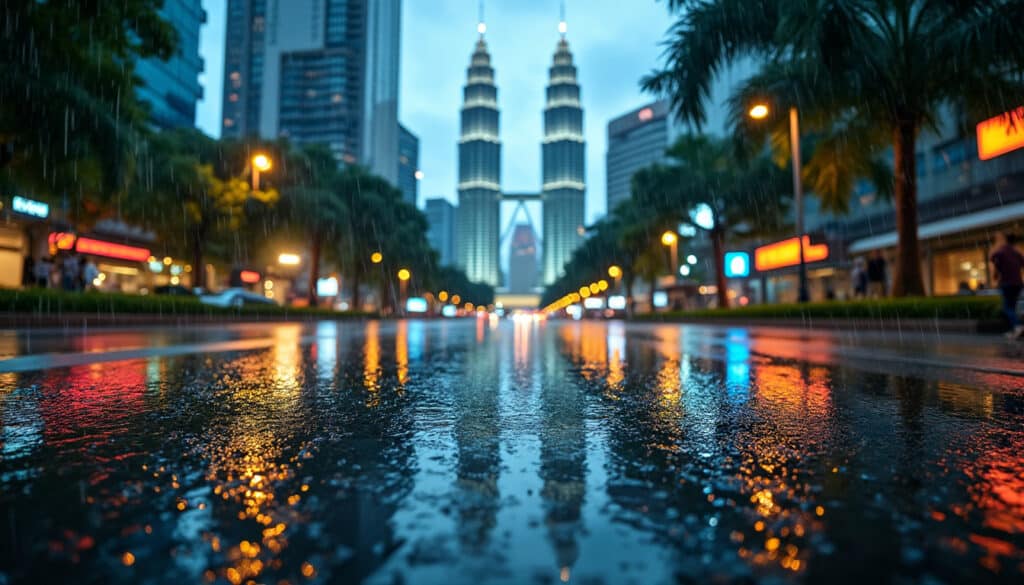
Rain and precipitation in Kuala Lumpur
Kuala Lumpur, the bustling capital of Malaysia, is known for its towering skyscrapers, vibrant street markets, and rich cultural history. However, one cannot overlook the city’s tropical rainforest climate, which brings with it frequent and substantial rainfall. This article delves…

Kuala Lumpur, the bustling capital of Malaysia, offers a vibrant blend of tradition and modernity, appealing to travelers worldwide. With its iconic skyline, rich cultural festivals, and diverse culinary delights, the city presents a unique experience every month of the…

The sight of the morning sun gracing the sky of Kuala Lumpur is a spectacle that remains unmatched. As the city awakens, the transition from darkness to light creates a vibrant backdrop against the modern skyline, making it an ideal…

Weather in Kuala Lumpur by month
The vibrant city of Kuala Lumpur, nestled in the heart of Malaysia, offers a unique blend of cultural diversity, modern sophistication, and tropical climates. With towering skyscrapers juxtaposed against antique structures, it’s a vibrant place where traditions meet the future.…

What is the weather like in Kuala Lumpur?
The bustling city of Kuala Lumpur, Malaysia’s vibrant capital, offers an alluring mix of modern architecture and traditional culture. The weather, an essential aspect for any traveler planning a trip, plays a crucial role in enhancing the experience. With a…

